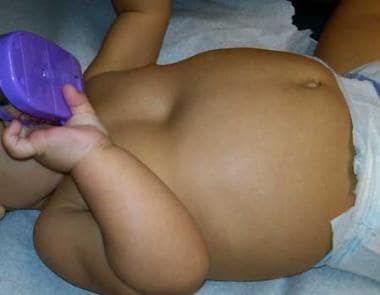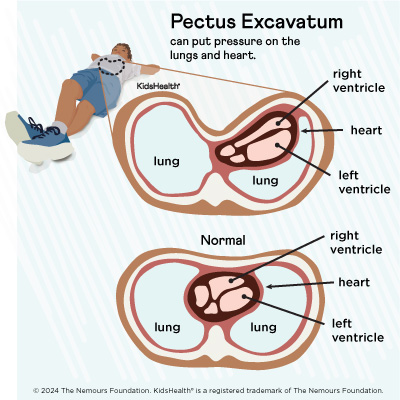pectus excavatum baby causes
The two most common congenital chest wall deformities fall into the categories of pectus carinatum sometimes called pigeon chest or sternal protrusion and pectus excavatum also called funnel chest or sunken sternum. Pectus excavatum is due to too much growth of the connective tissue that joins the ribs to the breastbone.
One of the symptoms may be if your baby is crying very often for no particular reason.

. Pectus excavatum sometimes called cobblers chest sunken chest or funnel chest is the most common chest deformity affecting between 1 in 300 and 1 in 500 adolescents. Pectus excavatum is usually congenital present at. It is caused when several ribs and the sternum grow abnormally which produces a caved-in or sunken appearance of the chest.
Infants and very young children are usually not considered for surgery unless very severe abnormalities or other illnesses necessitate earlier surgery. Pectus excavatum occurs in a baby who is developing in the womb. It is believed to be a disorder of the cartilage that joins the ribs to the breastbone.
Pectus excavatum PECK-tuss ex-kuh-VAW-tum is a condition that causes a childs chest to look sunken or caved in It happens because of a defect in the tough connective tissue cartilage that holds the bony part of the ribs to the breastbone. Pectus excavatum is a congenital deformity of the chest wall that causes several ribs and the breastbone sternum to grow in an inward direction. Pectus excavatum is a congenital chest wall deformity that is caused by growth abnormality of the cartilage that connects the ribs to the breastbone sternum.
At age 14 that he had the genetic condition known as pectus excavatum which causes the breastbone to sink into the chest sometimes dramatically. The condition is not always noticeable at birth but is often apparent by the time a child is 2 to 3. The most common chest wall deformity pectus excavatum or sunken chest is most likely caused by abnormal growth of the costal cartilage junction between the ribs and sternum.
Intermittent shortness of breath. Causes of Pectus Excavatum. Chest pain related to abnormal bone and cartilage growth.
A worsening of symptoms as the child grows. I was in junior high a time when your. Both or just one side of the breastbone may be affected.
Although we dont know exactly what causes pectus excavatum it is thought that the cartilages grow differently or unusually and this pushes the sternum inward creating the sunken look. Pectus excavatum also known as concave chest or funnel chest is a deformity of your childs chest wall. The breastbone or sternum and some of the ribs grow abnormally causing a depression in the middle of the chest.
This makes it much harder for parents to recognize the problem. Depending on the type of pectus and diagnosis treatment may be surgical or nonsurgical depending on the level of severity. Some people also have abnormal curvatures of the spine like.
An overgrowth of the rib cartilages before and after birth causes the characteristic depression of the sternum breastbone. The deformity varies in severity ranging from a mild to severe indentation or protrusion. This causes a depression of the sternum and the chest has a sunken in or funnel chest appearance.
It can present in toddlers but typically becomes apparent during the growth spurt and puberty. Pectus excavatum is caused by the abnormal growth in the chest of the connective tissues cartilage that attach the breastbone sternum to the ribs. Pectus excavatum a deformity of the sternum and ribs caused by an unbalanced costochondral hypertrophy is a congenital abnormality with a prevalence of 1 per 1000 patients.
Usually the ribs and sternum go outward at the front of the chest. The chest may look uneven. Pectus carinatum is a childhood condition in which the sternum breastbone sticks out more than usual.
A depression of the sternal bone. Symptoms of Pectus Excavatum in Kids. 1 2 Pectus excavatum may be associated with connective tissue disorders such as Marfan and.
This causes a depression in the chest that can range from mild to severe. The condition can be mild or severe. What is pectus excavatum.
In pectus excavatum funnel chest the sternum breastbone is depressed in a concave shape and in pectus carinatum pigeon chest the sternum protrudes in a convex shape. While most patients do not have symptoms those with severe. With pectus excavatum the sternum goes inward to.
If kids are born with pectus excavatum it might not be noticeable at first. While the cause of this abnormality is unknown the fact that it tends to occur in families suggests that genetics may play a role. This information from Great Ormond Street Hospital GOSH is about pectus excavatum also known as funnel chest.
It can also develop in a baby after birth. Diagnosis and treatment are discussed. Pectus excavatum PE translated literally as hollowed chest and also referred to as sunken chest or funnel chest is the most common chest wall malformation seen in children.
A child with pectus excavatum usually has a depression in the center of the chest over the breastbone which may appear quite deep. The patient delivered a 3100 g male baby during the 39 th week of gestation by cesarean section with an Apgar score of 910. The condition is also called sunken.
Pectus excavatum can range from mild to severe and your child may or may not have symptoms related to the heart or lungs. Luckily there can be many symptoms that can be an indicator to seek medical help. Amongst doctors dealing with pectus excavatum there is a lot of discussion.
For example a patient with a severe pectus excavatum. Pectus excavatum affects about one in. Pectus excavatum is a condition in which instead of being level with the ribs the breastbone sternum is sunken so that the middle of the chest looks caved in.
Decreased endurance with exercise. Ultrasonographic images of pectus excavatum a Axial thoracic section pectus severity index is calculated by the ratio of the lateral diameter of the chest to the distance between the sternum and spine at the point. The condition affects more boys than girls.
It occurs mostly in boys and frequently more members in a family are affected. The cartilage pushes the breastbone sternum inward.

Nuss Procedure For Pectus Excavatum Background Indications Contraindications

Newborn Care Chest And Abdomen Philadelphia Fight

Pectus Excavatum Gejala Penyebab Hingga Pengobatan

Pectus Excavatum Exercises Improve Strength Pectus Excavatum Exercise Chest Workout
How To Deal With Your Child S Pectus Carinatum Condition Align Clinic

Pdf Prenatal Diagnosis Of Pectus Excavatum

Pectus Excavatum October 2017 Babies Forums What To Expect

Pectus Excavatum October 2017 Babies Forums What To Expect

Patient 2 Note Cafe Au Lait Spots Pectus Excavatum Widespaced Download Scientific Diagram

Pdf Essentials Of Pediatric Surgery

Pectus Excavatum From A Pediatric Surgeon S Perspective Abstract Europe Pmc

Features Of Rickets Such A Frontal Bossing Harrison Sulcus Pectus Download Scientific Diagram

Pectus Excavatum And Improve Your Homoeopathic Knowledge Facebook

Chest Wall Disorder Pectus Excavatum For Parents Primary Children S Hospital


